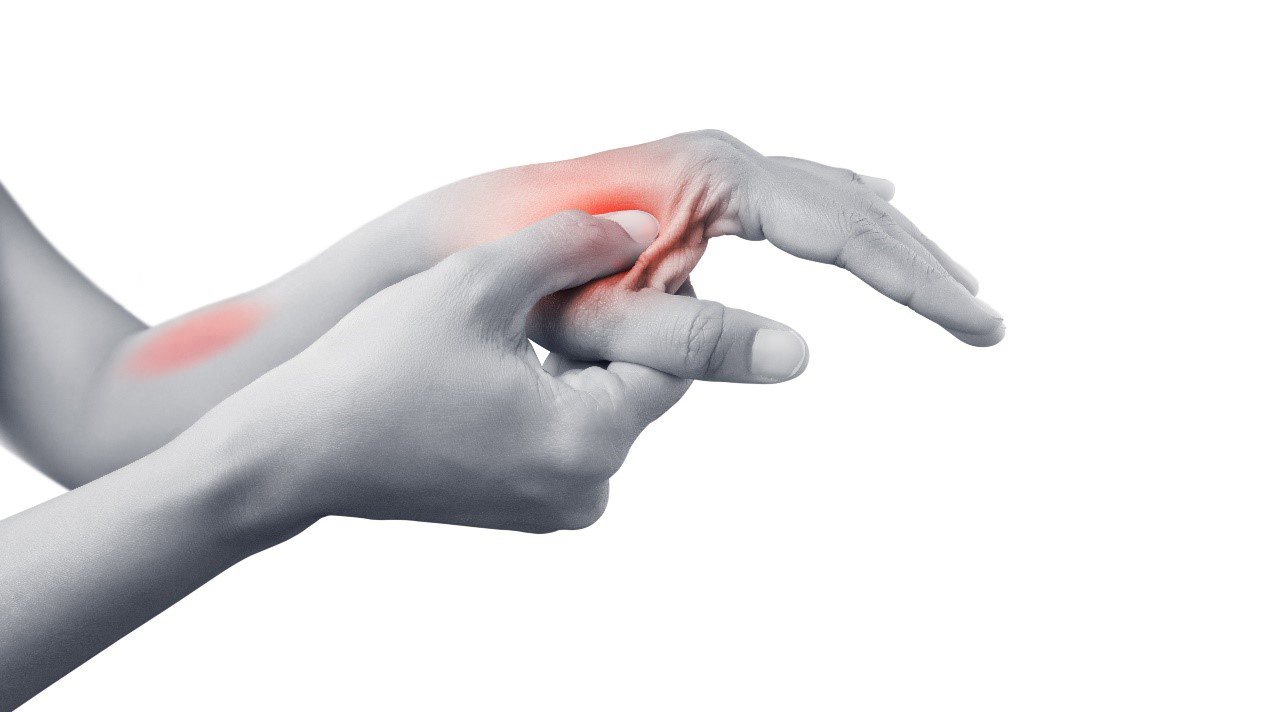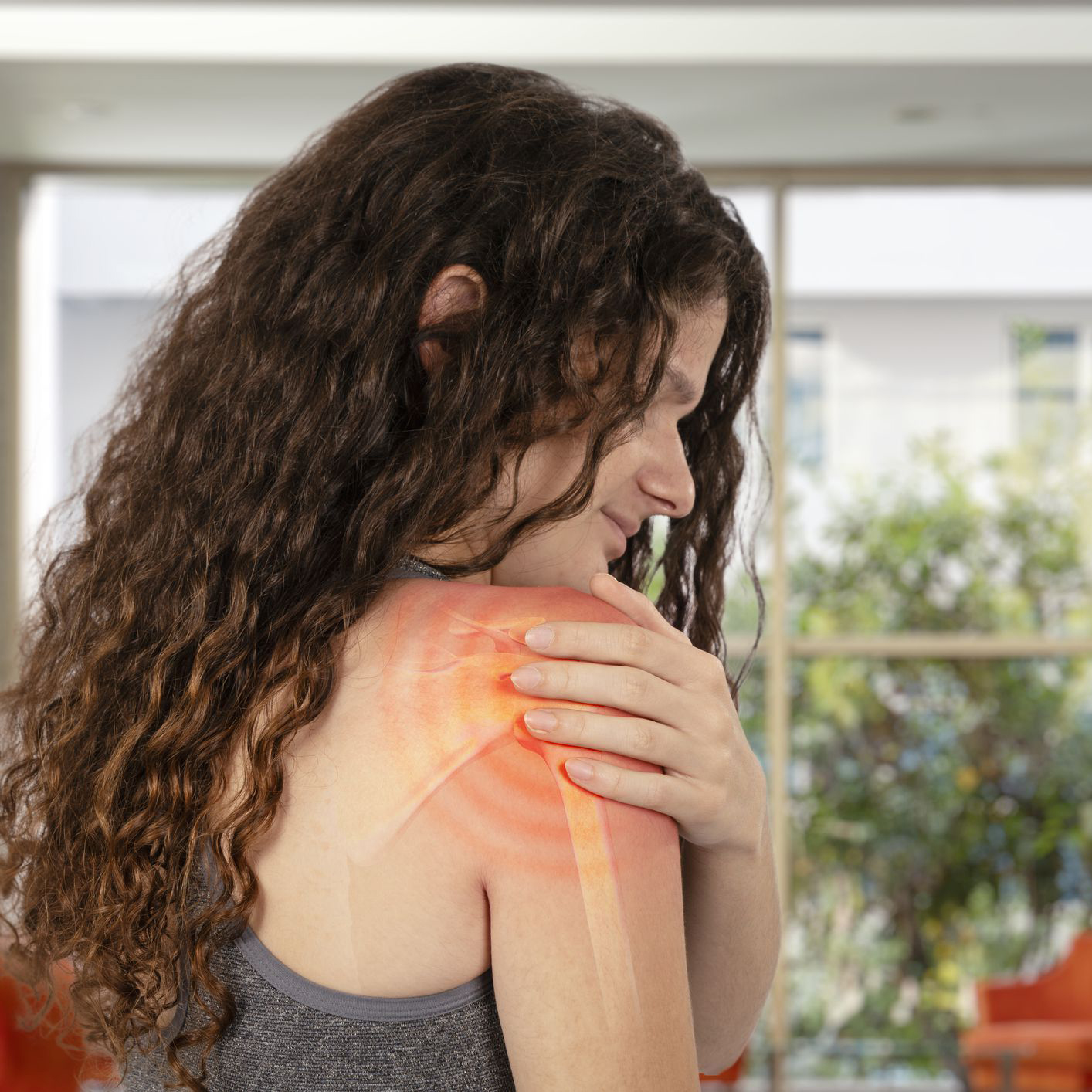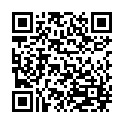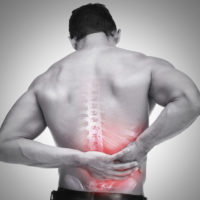
Low back pain is routinely listed as the largest cause of chronic pain in the US, responsible for more occupational disability than any other cause. This problem has deep roots in modern western lifestyles.
Many people have been through an episode of LBP that was severe enough to be referred for therapy. The craze to “strengthen your core” is largely a response to the low back problems associated with 21st century lifestyles. There is broad agreement about this. But, many people aren’t focusing on the right muscles…
Dynamic Movement Stabilization improves function and relieves pain. It is a simple method and it works. We continue to use and improve this approach for treating lower back pain with great success.
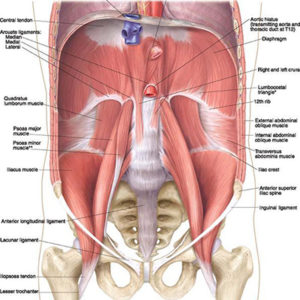 We define “core” muscles as lying very deep within your musculature, generally more concerned with stabilizing your body rather than moving it, and often operating with significant unconscious engagement.
We define “core” muscles as lying very deep within your musculature, generally more concerned with stabilizing your body rather than moving it, and often operating with significant unconscious engagement.
They are important in dynamic posture and stabilizing your body against movement. Examples of true “core” muscles would include:
- Diaphragm (the primary muscle of respiration)
- Transversus abdominis (or ‘TA’; the abdominal muscle used to brace/bear down)
- Quadratus Lumborum (or ‘QL’; lateral flexion and stabilizing the connection between hips, spine and ribs)
- Iliopsoas (the deep hip flexors)
- Multifidi (deep muscles responsible for segmental control of the spine)
- Longus Colli/Capitis (the deep cervical flexors)
We can see that four of these are visible in this deep abdominal view. They form a bridge between your spine and your hips.
A healthy TA is really important for low back health. This muscle is intimately connected with the diaphragm, the QL and the iliacus (the ‘ilio’ in iliopsoas). It forms a crucial bridge between breathing and movement.
Injury or overload of multifidi results in taut bands and trigger points that stimulate nerve roots in the lower back. This combines with other painful stinuli to activate peripheral and central sensitization. This is the escalation from simple injury to something that may be quite a bit worse.
- Situps and other abdominal exercises will NOT help and may actually cause back pain.
- Proper training of the deep abdominal muscles begins with diaphragmatic breathing and abdominal bracing.
- The intention of training of these and other core muscles is to provide stability as we move.
- Re-training these muscles includes movement therapy that recreates the developmental process we experienced as infants.
For more information on specific exercises for a healthy low back, check out our article on Reducing Low Back by Restoring Muscle Balance.
Extra – Anatomy of Deep Core Muscles
Looking at this illustration of the abdominal muscles we can see that the true “core” ab muscles is the TA. This is your “internal weight belt”. The muscles addressed by conventional ab work might give you a flat stomach but won’t support your lower back.
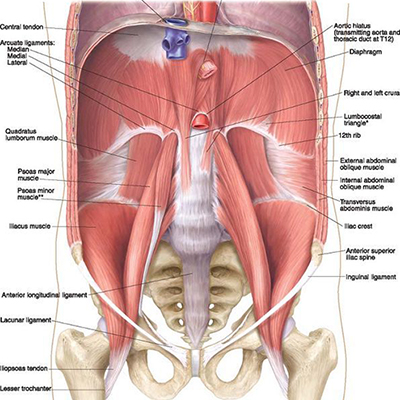 This also illustrates well how deep and how interconnected the diaphragm, TA, iliopsoas and (QL) are. They are the essence of core musculature. It also shows us why core strength and stability begins with the breath and the deep abdominal muscles.
This also illustrates well how deep and how interconnected the diaphragm, TA, iliopsoas and (QL) are. They are the essence of core musculature. It also shows us why core strength and stability begins with the breath and the deep abdominal muscles.
The iliopsoas is considered the primary flexor of the hip. However current anatomical research shows that along the QL, it also has a major role stabilizing the relationship of the trunk to the lower body as we move. It seems obvious just looking at the picture that these muscles are clearly helping to hold the trunk and lower body together.
Our spines suffer because the muscles and connective tissue at this critical junction are no longer working together effectively.
Another important group of core muscles that is rarely addressed by trainers and therapists are the multifidi and rotatores, pictured below:
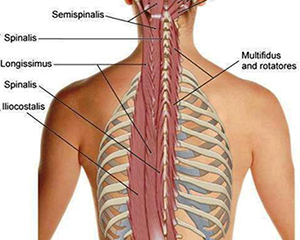 The muscles on the left are the more superficial spinal erector muscles. On the right they have been cut away to reveal the multifidi and rotatores – tiny muscles that run from one vertabra to another, allowing us precisely control the spine well – think of belly dancing…
The muscles on the left are the more superficial spinal erector muscles. On the right they have been cut away to reveal the multifidi and rotatores – tiny muscles that run from one vertabra to another, allowing us precisely control the spine well – think of belly dancing…
Note that to even show the spinal erectors, we needed to remove the very superficial trapezius, latissimus dorsi, rhomboid and serratus muscles.
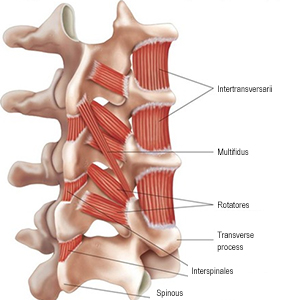
These tiny muscles, most less than an inch long, are the deepest spinal muscles. People that are otherwise very fit often have well developed spinal erectors but little or no development or activation of these smaller muscles.
Localized LBP is often directly related to tight bands and spasm of just a small number of multifidi.
They are also located very close the the nerve roots exiting the spine and can easily be irritated by leakage of small amounts of propulsus (the interior contents of a spinal disc) into the area.
Professional Treatment With Us
Take some time. Treat yourself. You deserve it.
Book a treatment this month and receive 20% off a three session package.
Janet was great. FANTASTIC person who knew how to treat and deal with my conditions. Very informative. Finally, someone who knew what I was talking about.
Really Good
It was interesting, and helpful for my IT band and hip
My experience was wonderful. Janet was very kind and attentive. I felt great after my session and would recommend to try it out.
The lady that assisted me was awesome! I suffer from fibromyalgia and when I left I felt like a brand new person! I plan to return when I get time!
Janet was great - knowledgeable and she found all my "hot spots."
Seriously, if you are looking for massage therapy that actually does your body good--that changes its function for the better and actually makes pain go away--then this is the place you need to come. Not Massage Envy. Not a chiropractor. You need trigger point from knowledgeable experts in the craft.
If your have pain in any part of your body this is the place to go. It focus on the muscles where the pain is. you will feel like a new person. Awesome will be returning. Thanks nice friendly and attentive
amazing!!!
I felt so much better after my appointment. Thank you and thanks for the self care tips!
Experienced therapist. Feel great after appointment...
Highly recommended!
What a great experience. The provider was able to recommend things I can do to improve my pain. Address issues I didn't even share with her that she was able to tell just by her exam and treating me for what i went for. Will be back. Feeling grateful
I spent so much money on chiropractors. This is much better. Everybody should try it out.
Beautiful, relaxing setting. Therapist was knowledgable and professional. I'll be going back. Thank you.
Janet is very informative. I loved that she explained which muscles/groups she was working on. I learned a lot about my posture and why some of my muscles are not activating. She also provided me with a list of considerations and excercises to improve my posture. I will be back!
Janet has a unique gift and talent in trigger point therapy. I’m definitely seeing her again!
I loved my experience. Janet is extremely knowledgeable in a vary wide variety of conditions. She is thorough and attentive. Makes you feel right at home!
It's like an hour of physical therapy (the good parts of P.T. where they massage you and stretch you). She also takes time to explain some ways to help your specific issues. Highly recommend!
Janet is very knowledgeable and informative. She thoroughly explains where you have weakness and what muscles are over compensating. She gives exercises, stretches, or everyday changes you can make to help you are progress on your own. I highly recommend a visit!
Janet was very knowledgeable and never in a hurry. She took her time explaining every little detail, great service
Felt much better after the trigger point massage, highly recommend.
Excellent
What About My Pain?
Clearly, everyone is different. Many of us have additional challenges and complications. Naturally, we tailor our treatment plans to the individual. However, there are common foundations in this work with everyone.
Fortunately, if you are having similar issues, you may find that a just few treatment sessions helps! We will identify and treat root causes of your individual case.
Clearly, everyone is different. Many of us have additional challenges and complications. Naturally, we tailor our treatment plans to the individual. However, there are common foundations in this work with everyone.
We are licensed professionals. In addition, we all have additional training and certifications in advanced techniques. For instance, this includes trigger point therapy, fascial stretching, neuromuscular and movement therapy. Also we offer kinesio taping, myofascial release, cupping, acoustic compression, self-care classes and more. In fact, we often combine several of these techniques into a single session..
Of course, no one wants chronic pain! Fortunately, can work together with you to help sort out the issues.
Click here or all us at 630-858-0000 today to make an appointment!
More info at: WestSubPainRelief.com
You can also take a picture of this QR code with another phone and share or view the entire article:
If reading from a pdf or printout, you will find links and videos at: https://WestSubPainRelief.com/core-low-back-pain

